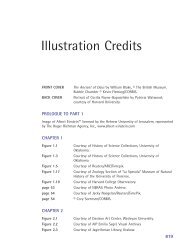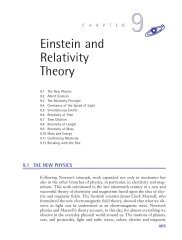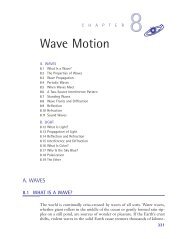Chapter 12: Electromagnetic Waves (545 KB) - D Cassidy Books
Chapter 12: Electromagnetic Waves (545 KB) - D Cassidy Books
Chapter 12: Electromagnetic Waves (545 KB) - D Cassidy Books
Create successful ePaper yourself
Turn your PDF publications into a flip-book with our unique Google optimized e-Paper software.
3637_<strong>Cassidy</strong>TX_<strong>12</strong> 6/13/02 11:33 AM Page 553<strong>12</strong>.2 MAXWELL’S PRINCIPLES OF ELECTROMAGNETISM 553mentally by Faraday and others. Maxwell then expressed the operation ofthe model in a group of equations that gave the relations between the electricand magnetic fields. He soon found these equations to be the most usefulway to represent the theory. Their power allowed him eventually to discardthe mechanical model altogether. Maxwell’s mathematical view is stillconsidered by physicists to be the proper approach to the theory of electromagneticphenomena. If you go on to take another physics course afterthis introductory one, you will find the development of Maxwell’s mathematicalmodel (Maxwell’s equation, using vector calculus) to be one of thehigh points of the course.Maxwell’s work contained an entirely new idea of far-reaching consequences:An electric field that is changing with time must be accompanied by amagnetic field. Not only do steady electric currents passing through conductors(a “conduction current”) produce magnetic fields around theconductors, but changing electric fields in insulators such as glass, air, oreven empty space also produce magnetic fields.It is one thing to accept this newly stated connection between electricand magnetic fields. But it is harder, and more interesting, to understandthe physical necessity for such a connection. The remainder of this sectionis intended to make it clearer.An uncharged insulator (such as glass, wood, paper, or rubber) containsequal amounts of negative and positive charges. In the normal state, thesecharges are distributed evenly. Thus, the net charge is zero in every regionof the material. But when the insulator is placed in an electric field, thesecharges are subjected to electrical forces. The positive charges are pushedin one direction, the negative in the opposite direction. Unlike the chargesin a conductor, the charges in an insulating material are not free to movefar through the material. The charges can be displaced only a small distancebefore restoring forces in the insulator balance the force of the electricfield. If the strength of the field is increased, the charges will be displacedfurther. But the changing displacement of charges that accompaniesa changing electric field in an insulator briefly forms a current. Maxwellcalled this current a displacement current. He assumed that this momentarydisplacement current in an insulator surrounds itself with a magnetic fieldjust as a conduction current of the same magnitude does.In an insulator, the displacement current is defined as the rate at whichthe charge displacement changes. This rate is directly proportional to the rateat which the electric field is changing in time. Thus, the magnetic field thatcircles the displacement current can be considered a consequence of thetime-varying electric field. Maxwell assumed that this model, developed formatter, also applies to space free of matter (though at first glance this mayseem absurd). Therefore, under all circumstances, as noted above, an elec-






